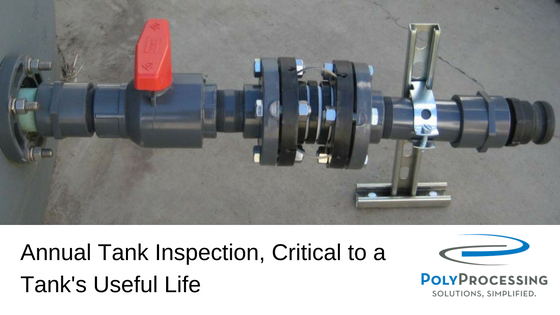Annual Tank Inspection, Critical To A Tank's Useful Life

Safe chemical containment is not only the tank, its material, fittings, and accessories. Over time, chemical storage tanks become susceptible to cracks and leaks, and it is of the utmost importance to find any potential problems before they cause costly mishaps. This is why Poly Processing recommends an annual tank system inspection.
A comprehensive tank inspection examines your investment for cracks and crazing, gasket and fitting issues, and other critical points on the tank’s surface that may become compromised.
What Chemical Tank Components Are Inspected
.jpg?width=256&name=MVC-024S%20(1).jpg) Even relatively new polyethylene tanks should receive routine and careful visual inspections. Careful inspection guidelines should be followed to ensure the safety of personnel and the preservation of the chemical stored.
Even relatively new polyethylene tanks should receive routine and careful visual inspections. Careful inspection guidelines should be followed to ensure the safety of personnel and the preservation of the chemical stored.
The inspection itself will examine the interior and exterior of the tank, notably areas around fittings and where different components of the system converge. Because of the oxidation that oxidizing chemicals can cause, it is necessary to also check areas of the tank that do not come into contact with the chemical itself. The fumes can make parts such as the dome brittle. You’ll also need to inspect the fittings themselves, any flexible connections, and gaskets, as well as vents and fume scrubbers. Lastly, if you are using a SAFE-Tank, you’ll want to do a visual inspection of the containment tank.
How To Inspect Your Tank Each Year
Below are a few of the steps we suggest when looking to perform your annual inspection, which you can also find in our Installation Guide.
- Empty the tank. Neutralize any chemical remaining. Thoroughly clean the exterior and interior of the tank. A dirty tank cannot be properly inspected.
- Examine the exterior and the interior of the tank for cracking, crazing and brittle appearance.
- Pay particular attention to areas around fittings and where different portions of the tank converge into one another. In other words, give special attention to “corners” where sidewall and the dome meet and where sidewall and the bottom meet.
- If a confined space entry is not feasible, use a bright light source to inspect the tank interior from the manway opening. An interior inspection is essential because stress cracks normally show up on the inside of a tank before appearing on the outside.
- Don’t forget to inspect areas of the tank that never actually come in contact with the chemical stored. With fume-emitting chemicals, oxidation and resulting embrittlement of the dome can occur without any actual contact with the chemical stored.
- Inspect fittings, flexible connections, and gaskets for leaks and signs of general corrosion or deterioration.
- Inspect vents and fume scrubbers to ensure adequate venting for pressure and vacuum. Ensure end of scrubber piping is never submerged in more than 6-in of liquid.
- Confirm that filling of the tank from tanker trucks is not causing pressurization and not ending with a line purge that “balloons” the tank.
- Confirm secondary containment is appropriate for chemical stored, adequate in size, and in good condition.
Do You Need A More Thorough Tank Inspection?
Your tank inspection should be done annually, but every 3-5 years we also recommend a professional perform a more in-depth inspection with testing. A Poly Polyprocessing field service representative will examine the appearance and functionality of the tank and all its accoutrements, as well as verify chemical and tank compatibility.
Learn more about chemical storage tank inspection by downloading our inspection checklist or by reaching out to one of our Field Service team members.
- December 8, 2016
- Topics: Installation and Field Service
About Poly Processing
Posts By Topic
Tech Talk Podcast Episodes
Subscribe By Email
Recent Posts
- Installation Tips for Chemical Storage Tanks: Site Preparation and Offloading
- Understanding pH and Chemical Concentration When Choosing a Chemical Tank
- Maximizing Fill Efficiency: Selecting the Optimal Fill Line System
- Chemical Storage Tanks: A Quick Guide for End Users
- Popular Customization Options for Chemical Storage Tanks
Tank Configurator

Find the recommended tank and system components for your chemical storage challenge.
Configure a Tank Package


